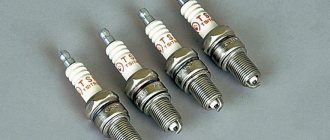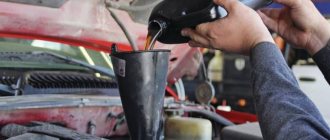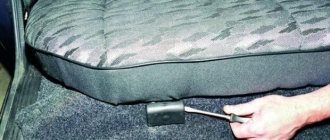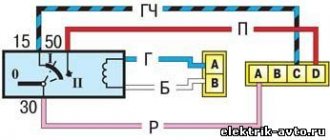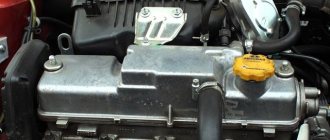November 26, 2014 Lada.Online 171 911 3
The Lada Granta is a budget front-wheel drive car that was developed on the basis of the Lada Kalina. Sales of the car began at the end of December 2011. Currently, 5 types of engines are installed on Lada Granta/Kalina 2:
- VAZ-11183-50 (82 hp)
- VAZ-11186 (87 hp)
- VAZ-21126 (98 hp)
- VAZ-21127 (106 hp)
- VAZ 21126-77 (120 hp)
Despite this diversity, the volume of all engines is the same and is 1.6 liters.
Short description
The VAZ-21126 engine can be used for installation on the VAZ-2170 LADA Priora and its modifications, LADA Granta, LADA Kalina, LADA Kalina 2. The VAZ-21126 internal combustion engine is a deep modernization of the 1.6-liter VAZ-21124 engine. Its development was carried out simultaneously with the internal combustion engine of the VAZ-11194. Despite the different displacement of these models, most engine components and systems are the same. One of the main tasks when creating these engines was to achieve a significant increase in the service life of the main components. The use of new technologies and design solutions allowed the manufacturer to increase engine life.
Review of basic Lada Granta engines
Over the entire production period of the Lada Grant, the car was equipped with gasoline engines of the following modifications:
Engines LADA GRANTA
The engine of each type is a prototype of the earlier 1.5-liter version 2111. Improved designs with the “old” cylinder diameter of 82 mm by increasing the piston stroke to 75.6 mm turned out to be more powerful and productive.
The design of all types of power units is quite similar. Newer 16-valve modifications of the VAZ 21126 and VAZ 21127 engines provide good power indicators in comparison with the previous installed models. This result was achieved by investing 39% of the piston group.
Engine characteristics VAZ 21126 1.6 16V Priora, Granta, Kalina 2
| Parameter | Meaning |
| Configuration | L |
| Number of cylinders | 4 |
| Volume, l | 1,597 |
| Cylinder diameter, mm | 82 |
| Piston stroke, mm | 75,6 |
| Compression ratio | 11 |
| Number of valves per cylinder | 4 (2-inlet; 2-outlet) |
| Gas distribution mechanism | DOHC |
| Cylinder operating order | 1-3-4-2 |
| Rated engine power / at engine speed | 72 kW-(98.0 hp) / 5600 rpm |
| Maximum torque/at engine speed | 145 Nm / 4000 rpm |
| Supply system | distributed injection with electronic control |
| Recommended minimum octane number of gasoline | 95 |
| Environmental standards | Euro 4 |
| Weight, kg | 115 |
Cylinder block
The block is cast from high-strength cast iron. Cylinder numbering is carried out on the installation side of the crankshaft pulley. Each cylinder, based on the results of measuring its diameter, is assigned a size class.
| Parameter | Meaning |
| Material | ductile iron |
| Cylinder diameter, mm | 82 |
| Intercylinder distance (distance between the axes of adjacent cylinders of the block), mm | 89 |
| Block height (distance between the upper plane of the block and the axis of the crankshaft), mm | 197,10 |
| Diameter of boring of crankshaft supports (for main bearings), mm | 54,52 |
| Weight, kg | 31,000 |
Block 21126 is painted gray. Wall processing is carried out in accordance with the requirements of Federal Mogul. Block 21126 has three classes every 0.01 mm (A, B, C). The cylinder class mark is located on the bottom plane of the block.
Design features of the Lada 21126 16 valve engine
The main difference between this internal combustion engine and its predecessors is the widespread use of foreign components in the assembly. First of all, this concerns a lightweight connecting rod and piston group manufactured by Federal Mogul, as well as a timing belt with an automatic tensioner from Gates.
Due to the strict requirements of the American company, the manufacturer of ShPG, additional procedures are carried out on the conveyor for processing the surfaces of the block, as well as honing the cylinders. There were also some disadvantages here: new pistons without holes made the power unit plug-in. Update: from mid-2021, the engines received an update in the form of plugless pistons.
Otherwise, everything is familiar here: a cast-iron block, which traces its history back to the VAZ 21083, a 16-valve aluminum head with two camshafts, standard for VAZ products, the presence of hydraulic compensators eliminates the need to adjust the valve clearances.
The video shows the consequences of a broken timing belt and subsequent head repair.
Source
connecting rod
| Parameter | Meaning |
| Length, mm | 133,32 |
| Upper head hole diameter, mm | 18 |
| Weight, g | 412 |
The connecting rod is not divided into classes based on the diameter of the upper head hole; there is no such marking on it. Connecting rods are divided into classes based on weight. The marking is stamped on the upper head of the connecting rod (F, L, B, X, M, V, C, N, G). The difference in weight between classes is ± 7 grams. For engine 21126, it is possible to install connecting rods with two or three marks.
Piston
| Parameter | Meaning |
| Diameter, mm | 82 |
| Compression height, mm | 25,4 |
| Volume of internal recess, ss | 0,125 |
| Weight, g | 247 |
The outer diameter of the piston pin of engines 11194 and 21126 is the same - there is no breakdown into classes. The outer diameter of the piston pin 11194 and 21126 is 18 mm. Finger 21126 with a length of 53 mm has a mass of 69.5 g.
The engine is the basis of any car - without it there is no movement and Drive! The engine on the Priora comes in 2 modifications: 21126 and 21127, the second is essentially a modified 126 engine, which has been installed on Lada Priora since 2013. after restyling the Lada Priora car model.
126 engines (16 valves) are high-torque after 1000 rpm, and up to 4000 - this is the maximum torque, after 4 thousand the torque decays. The 127 engine, due to the distributed air intake, pulls well from below, damping out at about the same rate as its brother. If the running-in was carried out properly, then the engine life will be close to 200 thousand km. Overhaul of the engine of a Priora car, like the entire AvtoVAZ range, is subject to the garage - there is nothing supernatural about it. The price of spare parts is more expensive than tenths, but cheaper than foreign ones. Engine power of 98 and 106 hp allows you to feel confident on the road - well, certainly not a vegetable. I consider the main 2 disadvantages of the engine to be the unit: pump roller, timing belt. If one of these spare parts fails, the valve bends. 2 minus - camshaft plugs: when these rubber bands dry out at low temperatures, they are squeezed out along with the oil. If you don’t see this in time, there will be trouble! The fact that hydraulic compensators knock when cold is considered the norm - you can close your eyes to this, there will be no harm.
In the vast majority of cases, Lada Priora cars are equipped with a 16-valve engine (the 8-valve engine was “inherited” from the “ten” and was not warmly received by car enthusiasts).
The first 16 valve engine received number 126, the second – 127. The characteristics of the Priora engine No. 126 turned out to be so good and optimal that the car with this engine was sold most often. Repair of the Priora engine with 16 valves is not carried out so often, but you will have to look into it at least once every six months - in order to make sure with your own eyes that everything is in order with it. In addition, you need to keep an eye on the timing belt - if you miss this unit, you can get into big money. Read the article to the end, and we will tell you about these 2 units.
Add a comment Cancel reply
You must be logged in to post a comment.
I think it’s no secret that the Lada Granta is available with 4 different types of engines. And each power unit of this car has both its advantages and disadvantages. And many owners who want to buy a Grant do not know which engine to choose and which of these engines will be better for them. Below we will consider the main types of power units that are installed on this car.
VAZ 11183 - stands on the Grant “standard”
The biggest advantage of this engine is that it has a very reliable timing system and even if the timing belt breaks, the valves will not collide with the pistons, which means that you can simply change the belt (even on the road), and you can drive on. This engine is the easiest to maintain, since its design is completely identical to the well-known unit from 2108, only with an increased volume.
If you want to avoid problems with repair and maintenance, and not be afraid that the valves will bend if the belt breaks, then this choice is for you.
VAZ 21116 - set to “norm” on Grant
But in terms of dynamics, this engine outperforms a conventional 8-valve engine due to the lightweight internal combustion engine parts. And the power is about 87 hp, which is 6 horsepower more than the 21114. By the way, it works much quieter, which cannot be ignored.
VAZ 21126 and 21127 - on Grants in the “luxury” configuration
Motor 126 and 127: working life, differences
These engines on Priora had a displacement of 1.6 liters (or 1596 cm3). Optimal for city sedans, the engine size of the Lada Priora gave a good combination of dynamics and consumption: along with very decent acceleration, fuel consumption does not exceed sky-high numbers. Both engines received good marks, because the car behaved perfectly in the city and on the highway.
In fact, the 126 Priora engine became the first sixteen-valve engine for this model, and the 127 is a modified version, “overclocked” by AvtoVAZ designers. In addition to the same engine displacement, they have other identical characteristics. The in-line type of arrangement of four cylinders provides a simplified design that can be repaired on your own.
The distributed multipoint injection system is involved in creating a good, rich fuel-air mixture (a lean mixture can lead to breakdowns). The cylinder diameter is 82 mm, the piston stroke is 75.6 mm, the compression ratio is 11. The “engines” fall under the Euro 4 standard, they are powered by gasoline with an octane rating of 95.
The 126 engine for the Priora received the following characteristics: 98 hp. (72 kW at 5600 rpm), acceleration to 100 km/h in 11.5 seconds (with manual transmission), city consumption 9.1 l - 100 km (manual transmission), maximum torque - 145 Nm.
The 127 engine for the Priora was upgraded to the following figures: 106 hp. (78 kW at 5800 rpm), acceleration to 100 km/h in 11.5 seconds (with manual transmission), city consumption 8.9 liters per 100 km (with manual transmission), maximum torque – 148 Nm.
The difference may not seem so noticeable, but this is a very small but strong step in design on the part of AvtoVAZ (this is where the change to sixteen-valve “engines” with a volume of 1.6 liters ended). For a car of the Lada Priora class, the engine power was sufficient.
In the same block it is necessary to say about the operating temperature. An absolutely normal operating temperature is considered to be between 90 and 95 degrees Celsius. Further, when the car is being pushed in a traffic jam, is basking in the sun, or for some other reason, but can still work - from 97 to 110 degrees. The engine is slow in places and wears out a lot, but you can still get to your destination. A temperature below 90 degrees is a direct sign indicating that the car has not yet warmed up, and it is better to wait in place until the arrow points to the coveted 80-90 mark.
Operating a car at temperatures above 110 degrees is dangerous because the service life of the engine is noticeably reduced - hot parts undergo very severe wear, overcoming the force of friction.
In general, the service life of the Lada Priora engine with a normal driving style and careful treatment is 200,000 km - after this mark the time comes when the “engine” requires major repairs. AvtoVAZ mentioned the timing belt separately as a recommendation, saying that it needs to be checked every 100,000 km (many car enthusiasts talk about the figure of 50,000 km).
All Lada engines have a problem, and it is related to the valves, which will be discussed further.
Signs of the need for internal combustion engine repair
The reasons why the operation of the engine is disrupted are arranged in a small list, starting with refusal to start and ending with floating idle speed (this problem was removed on the 127 “engine”). Not all breakdowns end in capital damage - sometimes it’s enough to add oil, sometimes it’s enough to adjust the ECU settings.
Compression reduction
A decrease in cylinder compression below 16 atmospheres is a bad sign. Such a high limit corresponds to a compression ratio of 11.
If the compression decreases (or vice versa increases), then the “engine” will have to be rebuilt.
Knocks in the engine
Engine knocks can come from several points. These could be hydraulic compressors, timing belt rollers or pins. The knocking noise could also be caused by low oil level. The answer to the question will be given by a thorough detailed inspection of all parts of the unit and checking the oil level.
Blue smoke from the exhaust pipe
The blue smoke that comes from the exhaust pipe appears when oil enters the combustion chamber. It can leak either from the valves or from under the piston. The result is the same: the oil is eaten up and blue smoke pours out of the chimney. Once the leak is located, half the problem will already be solved.
Troit motor
Sometimes in the cold the engine may stall - don’t be alarmed by this, because it may simply be one of the spark plugs that fails. In this case, we advise you to simply restart the engine and it will stop running.
How much does it cost to overhaul a Priora engine - average price
Self-repair of a Priora engine with 16 valves costs an average of 16-20 thousand rubles. The cost depends on the severity of the breakdown and may be lower or higher than this average range. Repairing a Priora engine can be entrusted to the wrong hands, but then you will have to pay for the work - sometimes the cost of repairs reaches as much as 40 thousand rubles.
Priora engine characteristics
Years of production – (2007 – present day) Cylinder block material – cast iron Power system – injector Type – in-line Number of cylinders – 4 Valves per cylinder – 4 Piston stroke – 75.6 mm Cylinder diameter – 82 mm Compression ratio – 11 Priora engine volume – 1597 cm3 .cube Engine power of the Lada Priora is 98 hp. /5600 rpm Torque - 145 Nm / 4000 rpm Fuel - AI95 Fuel consumption - city 9.8 l. | track 5.4 l. | mixed 7.2 l/100 km Oil consumption in the Priora engine - 50 g/1000 km Weight of the Priora engine - 115 kg Geometric dimensions of the Priora 21126 engine (LxWxH), mm - Oil in the Lada Priora 21126 engine: 5W-30 5W-40 10W- 40 15W40 How much oil is in the Priors engine: 3.5 l. When digging, pour 3-3.2 liters.
Priora engine life: 1. According to the plant – 200 thousand km 2. In practice – 200 thousand km
TUNING Potential – 400+ hp. Without loss of resource - up to 120 hp.
Lada Granta Sport engine: main technical characteristics
The stylish, domestically produced sports car Lada Granta Sport is assembled by the AvtoVAZ subsidiary TMS-Sport. It is this version of a truly sports car that has been put into mass production and is one of the ten best representatives of its class.
The Lada Granta Sport is equipped with a modified 16-valve VAZ 21126 power unit. Among the modifications to the sport version, it is worth noting the installation of turbines, the operation of which reduced the acceleration of the car by 7 seconds to a speed of 100 km. At the same time, engine power increased to 200 hp. The turbocharging system creates pressure up to 1.2 atmospheres.
Engine LADA Granta Sport
The power unit is equipped with a five-speed sequential gearbox with a cermet clutch. The engine is installed without tilting on five supports.
A specially prepared sports Lada Granta with a turbocharger was a participant in the World Championship in road racing for passenger cars WTCC in 2013. The following year, 2014, the turbine was installed on a 2-liter engine, which gave power up to 380 hp. This is what gave the Lada Granta Sport an advantage during the competition driven by Robert Huff, where the Lada Sport team received first place.
Malfunctions and repairs of the Priora 21126 engine
The 21126 engine is a continuation of the VAZ 21124 ten-wheel drive engine, but with a 39% lighter ShPG produced by Federal Mogul, the holes for the valves have become smaller, and a different timing belt with an automatic tensioner, thanks to which the problem of tightening the belt on the 124 block has been solved. The Priora engine block itself has also undergone minor changes, such as better surface treatment, and cylinder honing is now carried out in accordance with the more stringent requirements of Federal Mogul. On the same block above the clutch housing there is a place with the Priora engine number; to see it, you need to remove the air filter and arm yourself with a small mirror. Engine VAZ 21126 1.6 l. injection in-line 4-cylinder with overhead camshafts, the gas distribution mechanism is belt driven. The service life of the 21126 Priora engine, according to the manufacturer’s data, is 200 thousand km, how long does the engine run in practice... depending on your luck, on average this is approximately the case. In addition, there is a lightweight version of this engine - Kalina engine 1.4 VAZ 11194, as well as a sports forced version - VAZ0 hp engine, an article about it is HERE. Among the disadvantages of this power unit, it is worth noting unstable operation, loss of power, timing belt. The reasons for unstable operation and refusal to start may be problems with fuel pressure, timing faults, faulty sensors, air leaks through hoses, or a malfunction of the throttle valve. Loss of power may be due to low compression in the cylinders due to a burnt-out gasket, wear of the cylinders, piston rings, or burnt-out pistons. A significant drawback is that the Priora 21126 engine bends the valves. The solution to the problem is to replace the pistons with plugless ones. However, the Priora engine is currently one of the most advanced domestic engines, perhaps the reliability is worse than that of the 124th, but the engine is also very good and powerful enough for comfortable movement in the city. In 2013, a modernized version of this engine was released, the marking of the new VAZ 21127 Priora engine, an article about it is HERE.
In 2015, production of the NFR sports engine began, called 21126-81, which used the 21126 base. And since 2021, cars with 1.8 liter engines 21179, which also used the 126th block, are available.
The most basic malfunctions of the 126 engine
Let's move on to the malfunctions and shortcomings, what to do if the Priora engine is running rough, sometimes flushing the injectors solves the problem, it may be the spark plugs or the ignition coil, but the usual thing in this case is to measure the compression in order to eliminate the problem of valve burnout. But the cheapest option is to go to a service center for diagnostics. Another common problem is when the engine speed of the Priora 21126 fluctuates and the engine runs unevenly, a common disease of VAZ sixteen valves, your mass air flow sensor is dead! Not dead? Then clean the throttle valve, there is a possibility that the TPS (throttle position sensor) needs to be replaced, perhaps the IAC (idle air regulator) has arrived. What to do if the car does not warm up to operating temperature, there may be a problem with the thermostat or the frost is too severe, then you will have to put cardboard on the radiator grill
